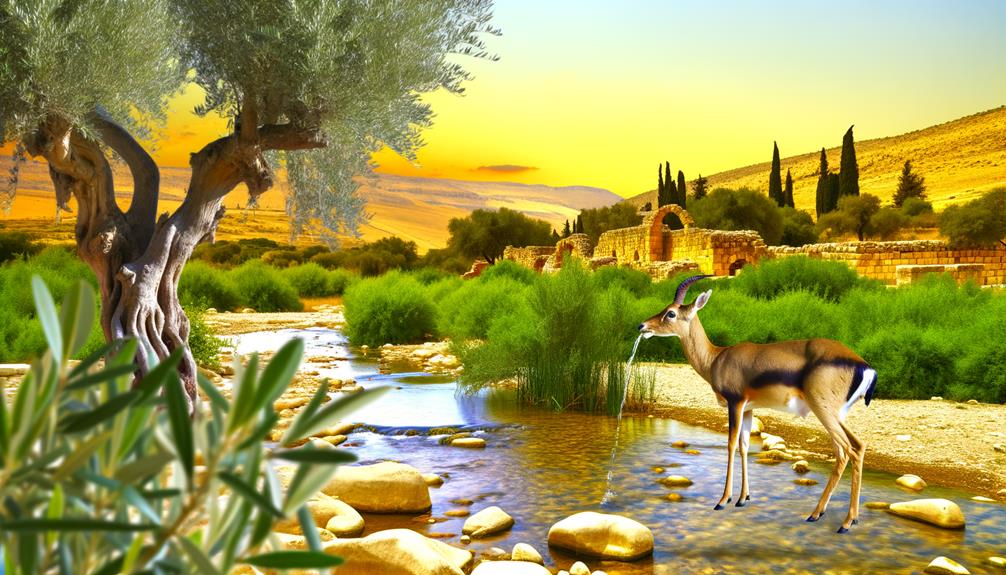Hart Meaning in the Bible: Symbol of Longing
In the Bible, the hart, or mature stag, symbolizes spiritual yearning, strength, and divine pursuit. Psalm 42:1 vividly portrays a hart’s thirst for water likened to the soul’s deep longing for God, underscoring an intrinsic desire for divine connection.
This imagery is prevalent within Judeo-Christian traditions, where the hart represents resilience and the relentless quest for spiritual nourishment. Prophetic texts, such as Isaiah 35:6, further symbolize it as a figure of joy and liberation.
The powerful symbolism of the hart enriches biblical narratives, illustrating profound truths about humanity’s spiritual journey. To explore this symbolism further, one can uncover deeper insights.

Hart Meaning in the Bible: Symbol of Longing, Strength, and Spiritual Pursuit
| Aspect | Biblical Interpretation |
|---|---|
| Literal Meaning | A male deer, known for agility and grace |
| Key Scripture | Psalm 42:1 – “As the hart pants after the water brooks…” |
| Symbolism | Spiritual thirst, pursuit of God, inner longing |
| Spiritual Insight | Represents the soul’s deep yearning for divine connection |
| Physical Traits | Speed, alertness, and grace—qualities admired in spiritual context |
| Theological Message | God fulfills the soul’s deepest needs and longings |
Biblical References to the Hart

In various passages throughout the Bible, the term ‘hart’ is used to symbolize strength, grace, and a deep yearning for the divine.
Significantly, the hart appears in Psalm 42:1, ‘As the hart panteth after the water brooks, so panteth my soul after thee, O God.’ This scriptural reference underscores a profound spiritual longing, likening the hart’s desire for water to the soul’s thirst for God.
Historically, the hart, an old English term for a mature stag, was admired for its regal bearing and swiftness.
This biblical imagery draws from ancient Near Eastern contexts where the hart’s attributes were well-known, infusing the text with rich, evocative meanings that resonate deeply within Judeo-Christian traditions.
Symbolism of the Hart

The symbolism of the hart in the Bible is rich with theological and spiritual implications, serving as a profound metaphor for the believer’s pursuit of God.
Historically, the hart is often depicted in Scripture as a symbol of longing and spiritual thirst, as seen in Psalm 42:1, ‘As the hart pants after the water brooks, so pants my soul after you, O God.’
This metaphor encapsulates the deep yearning for divine connection and highlights the hart’s role as an emblem of spiritual aspiration and purity.
Biblical Hart References
Throughout the Bible, the hart is frequently employed as a symbol of spiritual aspiration and divine pursuit.
Especially, Psalm 42:1 captures this imagery vividly: ‘As the hart panteth after the water brooks, so panteth my soul after thee, O God.’ This verse illustrates a deep, innate longing for communion with the Divine, emphasizing an earnest quest for spiritual fulfillment.
The hart’s agility and grace also signify the believer’s desire to ascend to higher spiritual dimensions. In ancient Israel, the hart represented purity and devotion, aligning with the broader biblical theme of seeking God’s presence with earnestness and humility.
This symbolism underscores humanity’s intrinsic yearning for a profound and intimate relationship with the Creator.
Hart as a Metaphor
As a potent metaphor within biblical scripture, the hart embodies the fervent and relentless pursuit of spiritual communion with God, reflecting a profound theological symbol of purity, devotion, and divine aspiration.
This imagery is poignantly illustrated in Psalm 42:1, ‘As the hart pants for the water brooks, so my soul pants for You, O God.’
Historically, the hart, or deer, was revered for its grace and swiftness, traits that accentuate its symbolic association with seeking and yearning for the divine presence.
Within the scriptural context, the hart’s unyielding quest for life-sustaining water parallels the believer’s deep-seated longing for spiritual nourishment and connection with the Creator, underscoring the essence of unwavering faith and commitment.
Spiritual Significance Explained
In exploring the spiritual significance of the hart within biblical texts, one can discern a multifaceted symbol that encompasses aspects of divine pursuit, purity, and the soul’s intrinsic yearning for God.
The hart, often depicted in Psalms, illustrates a deep, instinctive longing for divine connection, mirroring the human soul’s quest for spiritual fulfillment. Historically, the hart’s purity and gracefulness have made it an emblem of spiritual aspiration.
| Symbol | Biblical Reference | Meaning |
|---|---|---|
| Hart | Psalm 42:1 | Yearning for God |
| Deer | Song of Solomon 2:9 | Divine Presence |
| Stag | Habakkuk 3:19 | Strength and Grace |
| Roe | Proverbs 5:19 | Love and Beauty |
| Fawn | Isaiah 35:6 | Renewal and Joy |
This scriptural analysis reveals the rich, theological tapestry that the hart represents in biblical literature.
Hart in the Psalms

The presence of the hart in the Psalms serves as a powerful metaphor for spiritual longing and divine pursuit, encapsulating both the historical significance and theological depth of this majestic creature.
Psalm 42:1 poignantly states, ‘As the hart panteth after the water brooks, so panteth my soul after thee, O God,’ illustrating the hart’s thirst as a symbol of the human soul’s yearning for God.
This vivid imagery evokes a sense of desperate need for divine connection. It reflects the natural habitat of the hart, often found near water sources, symbolizing life and purity.
Additionally, it highlights the psalmist’s use of nature to convey profound spiritual truths. Such scriptural analysis underscores the hart’s role in expressing deep spiritual desires within the Psalms.
Prophetic Imagery of the Hart

Frequently appearing in prophetic literature, the hart symbolizes not only spiritual pursuit but also divine revelation and eschatological hope.
In Isaiah 35:6, the leaping hart epitomizes the joy and liberation associated with God’s future restoration of Israel. This imagery underscores the transformation from desolation to a flourishing, life-giving wilderness, symbolizing divine intervention.
Historically, the hart’s swift and graceful movements were seen as metaphors for the soul’s yearning for God, reflecting a deep-seated spiritual quest.
Scripturally, the hart’s depiction aligns with prophetic themes of renewal and ultimate redemption, serving as a powerful emblem of God’s promises.
Consequently, the hart in prophetic texts encapsulates a vision of future glory and spiritual fulfillment, resonating with themes of hope and divine presence.
Hart in Biblical Poetry

Building upon the prophetic imagery, the hart also occupies a significant place in biblical poetry, where its portrayal enriches the thematic landscape of spiritual longing and divine intimacy.
In the Psalms, the hart symbolizes a soul’s deep thirst for God, encapsulated in Psalm 42:1, ‘As the hart panteth after the water brooks, so panteth my soul after thee, O God.’
This poetic expression underscores:
- Spiritual Thirst: Reflecting a profound desire for divine presence.
- Divine Pursuit: Illustrating the relentless quest for spiritual fulfillment.
Cultural Context of the Hart

The hart, or deer, holds significant symbolic weight within biblical texts, often representing spiritual pursuit and divine provision.
Understanding this symbolism requires examining the fauna of the Ancient Near East, where the hart was both a familiar and revered creature.
This cultural context enriches our interpretation of scriptural passages that reference the hart, illuminating its role in conveying deeper theological truths.
Symbolism in Biblical Texts
In biblical texts, the hart, often a symbol of purity and divine pursuit, is deeply rooted in the cultural and historical context of ancient Israel.
The hart’s portrayal in scripture showcases significant theological and symbolic themes:
- Purity and Innocence: The hart’s graceful nature and serene presence often symbolize a soul seeking God’s purity.
- Divine Thirst: Psalms frequently depict the hart as a creature that longs for water, paralleling a believer’s deep spiritual thirst for God.
Understanding these symbols within their ancient context enriches our comprehension of biblical narratives and enhances our spiritual reflection.
Ancient Near Eastern Fauna
Examining the cultural context of the hart within the ancient Near Eastern fauna reveals the intricate relationship between wildlife and theological symbolism in biblical narratives.
The hart, or male deer, was a common sight in the diverse landscapes of the Near East, from wooded areas to open plains. This familiarity allowed the hart to become a potent symbol in scripture, often representing strength, agility, and a deep thirst for spiritual fulfillment.
In Psalm 42:1, the psalmist’s yearning for God is likened to a hart panting for water brooks, signifying an intense spiritual longing.
Understanding the hart in its historical and ecological context enriches our appreciation of its symbolic depth in biblical texts, reflecting both natural reality and spiritual metaphor.
Lessons From the Hart

Drawing from the biblical symbolism of the hart, one can unearth profound spiritual lessons that resonate through both Old and New Scriptures teachings. By examining the graceful and elusive nature of the hart, believers are invited to pursue God with similar fervor and dedication.
- Spiritual Thirst: The Psalmist’s cry, “As the hart panteth after the water brooks, so panteth my soul after thee, O God” (Psalm 42:1), underscores the necessity of seeking divine refreshment.
- Resilience and Strength: Harts, known for their agility and endurance, symbolize the strength found in reliance on God amidst adversities.
Conclusion
The hart, as depicted in Biblical scripture, serves as a profound allegory for spiritual pursuit and divine yearning.
Through its recurrent presence in Psalms and prophetic imagery, the hart embodies the soul’s quest for God’s presence amidst life’s trials.
This elegant creature, woven into the poetic and cultural tapestry of ancient texts, invites contemplation on the deeper symbolic meanings within the sacred narratives.
Consequently, the hart stands as a timeless emblem of faith, perseverance, and spiritual aspiration.






